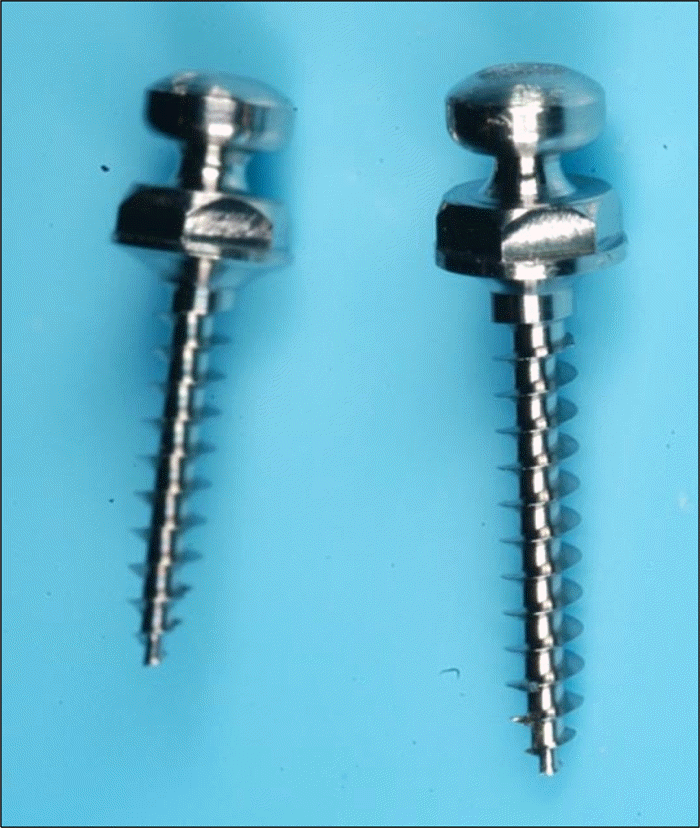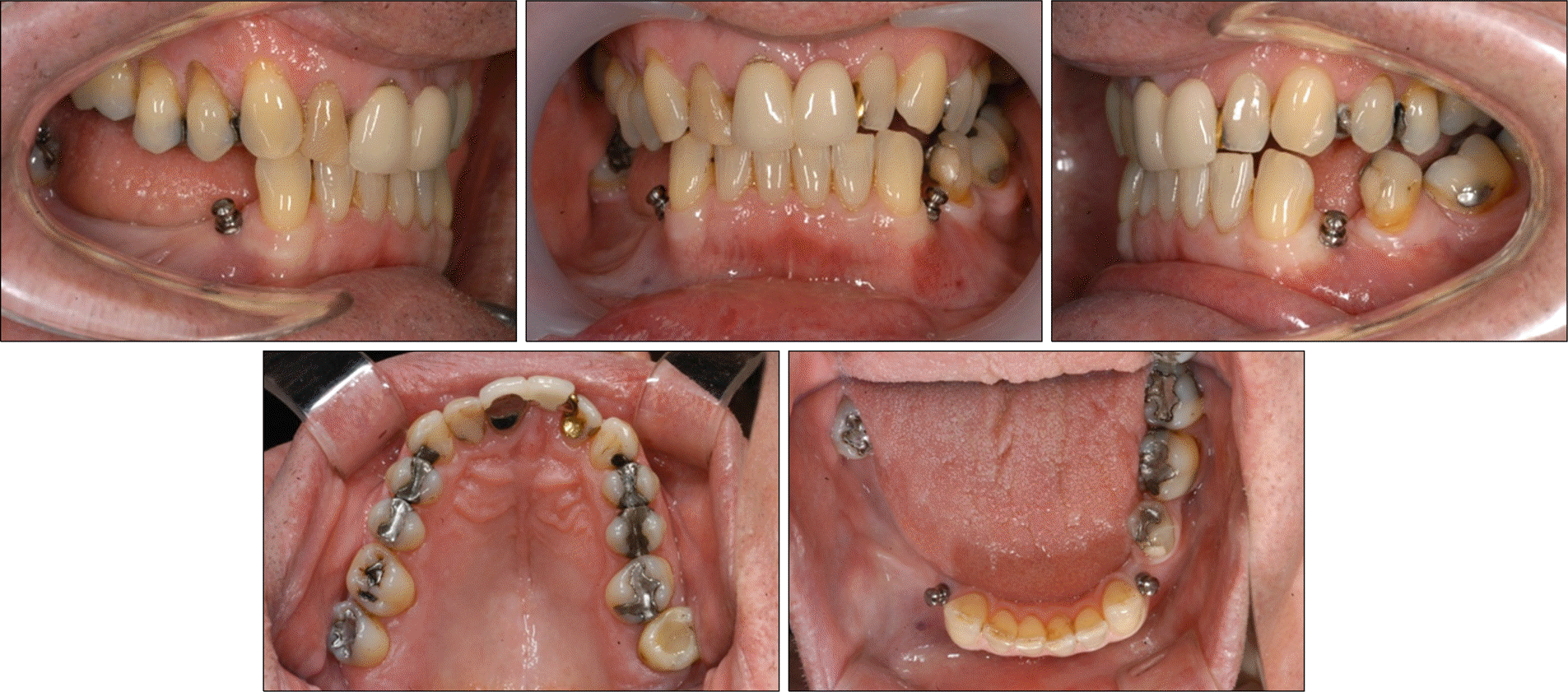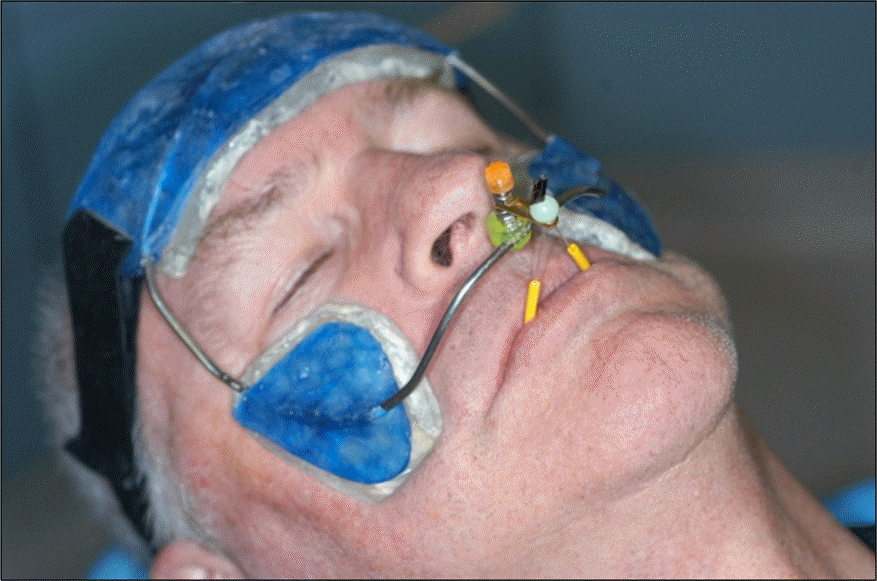Abstract
This case report describes the treatment of a 66 year old adult patient with a diagnosis of severe obstructive sleep apnea who was intolerant of nasal continuous positive airway pressure (nCPAP) treatment and oral appliance therapy. An alternative treatment of snoring and obstructive sleep apnea (OSA) with 2 orthodontic microimplants anchored to the mandible providing skeletal anchorage for mandibular advancement was implemented. After a 2 week healing period, a custom designed facemask provided extraoral anchorage to which the microimplants were connected to for titratable mandibular advancement. Microimplant Mandibular Advancement (MiMA) therapy resulted in resolution of the symptoms of severe OSA with a reduction of the apnea-hypopnea index (AHI), snoring and OSA symptoms.
Go to : 
REFERENCES
1.Kim J., In K., You S., Kang K., Shim J., Lee S, et al. Prevalence of sleep-disordered breathing in middle-aged Korean men and women. Am J Respir Crit Care Med. 2004. 170:1108–13.

2.Joo S., Baik I., Yi H., Jung K., Kim J., Shin C. Prevalence of excessive daytime sleepiness and associated factors in the adult population of Korea. Sleep Med. 2009. 10:182–8.

3.Lee SA., Amis TC., Byth K., Larcos G., Kairaitis K., Robinson TD, et al. Heavy snoring as a cause of carotid artery atherosclerosis. Sleep. 2008. 31:1207–13.
4.Sullivan CE., Issa FG., Berthon-Jones M., Eves L. Reversal of obstructive sleep apnoea by continuous positive airway pressure applied through the nares. Lancet. 1981. 1:862–5.

5.Hwang SH., Park IS., Nam KY., Kim JB., Cho YW., Suh YS, et al. Cephalometric differences in obstructive sleep apnea between obese and non-obese Korean male patients. Korean J Orthod. 2008. 38:202–13.

6.Mehta A., Qian J., Petocz P., Darendeliler MA., Cistulli PA. A randomized, controlled study of a mandibular advancement splint for obstructive sleep apnea. Am J Respir Crit Care Med. 2001. 163:1457–61.

7.Panula K., Keski-Nisula K. Irreversible alteration in occlusion caused by a mandibular advancement appliance: an unexpected complication of sleep apnea treatment. Int J Adult Orthodon Orthognath Surg. 2000. 15:192–6.
8.Petit FX., Pepin JL., Bettega G., Sadek H., Raphael B., Levy P. Mandibular advancement devices: rate of contraindications in 100 consecutive obstructive sleep apnea patients. Am J Respir Crit Care Med. 2002. 166:274–8.
9.Kyung HM., Park HS., Bae SM., Sung JH., Kim IB. Development of orthodontic microimplants for intraoral anchorage. J Clin Orthod. 2003. 37:321–8.
10.Lee HA., Park YC. Treatment and posttreatment changes following intrusion of maxillary posterior teeth with miniscrew implants for open bite correction. Korean J Orthod. 2008. 38:31–40.

11.Park HS., Kyung HM., Sung JH. A simple method of molar uprighting with micro-implant anchorage. J Clin Orthod. 2002. 36:592–6.
12.Kuroda S., Katayama A., Takano-Yamamoto T. Severe anterior open-bite case treated using titanium screw anchorage. Angle Orthod. 2004. 74:558–67.
13.Yao CC., Lai EH., Chang JZ., Chen I., Chen YJ. Comparison of treatment outcomes between skeletal anchorage and extraoral anchorage in adults with maxillary dentoalveolar protrusion. Am J Orthod Dentofacial Orthop. 2008. 134:615–24.

14.Takano-Yamamoto T., Kuroda S. Titanium screw anchorage for correction of canted occlusal plane in patients with facial asymmetry. Am J Orthod Dentofacial Orthop. 2007. 132:237–42.

15.Park HS., Jeong SH., Kwon OW. Factors affecting the clinical success of screw implants used as orthodontic anchorage. Am J Orthod Dentofacial Orthop. 2006. 130:18–25.

16.Lee SY., Cha JY., Yoon TM., Park YC. The effect of loading time on the stability of mini-implant. Korean J Orthod. 2008. 38:149–58.

17.Kushida CA., Morgenthaler TI., Littner MR., Alessi CA., Bailey D., Coleman J Jr, et al. Practice parameters for the treatment of snoring and Obstructive Sleep Apnea with oral appliances: an update for 2005. Sleep. 2006. 29:240–3.

18.Pepin JL., Leger P., Veale D., Langevin B., Robert D., Levy P. Side effects of nasal continuous positive airway pressure in sleep apnea syndrome. Study of 193 patients in two French sleep centers. Chest. 1995. 107:375–81.
19.Clark GT., Blumenfeld I., Yoffe N., Peled E., Lavie P. A crossover study comparing the efficacy of continuous positive airway pressure with anterior mandibular positioning devices on patients with obstructive sleep apnea. Chest. 1996. 109:1477–83.

20.Tegelberg A., Wilhelmsson B., Walker-Engstrom ML., Ringqvist M., Andersson L., Krekmanov L, et al. Effects and adverse events of a dental appliance for treatment of obstructive sleep apnoea. Swed Dent J. 1999. 23:117–26.
21.Battagel JM., Kotecha B. Dental side-effects of mandibular advancement splint wear in patients who snore. Clin Otolaryngol. 2005. 30:149–56.

22.Pantin CC., Hillman DR., Tennant M. Dental side effects of an oral device to treat snoring and obstructive sleep apnea. Sleep. 1999. 22:237–40.

23.Rose EC., Staats R., Virchow C Jr., Jonas IE. Occlusal and skeletal effects of an oral appliance in the treatment of obstructive sleep apnea. Chest. 2002. 122:871–7.

24.de Almeida FR., Lowe AA., Tsuiki S., Otsuka R., Wong M., Fastlicht S, et al. Long-term compliance and side effects of oral appliances used for the treatment of snoring and obstructive sleep apnea syndrome. J Clin Sleep Med. 2005. 1:143–52.

25.Marklund M., Franklin KA., Persson M. Orthodontic side-effects of mandibular advancement devices during treatment of snoring and sleep apnoea. Eur J Orthod. 2001. 23:135–44.

26.Hoekema A., de Vries F., Heydenrijk K., Stegenga B. Implant-retained oral appliances: a novel treatment for edentulous patients with obstructive sleep apnea-hypopnea syndrome. Clin Oral Implants Res. 2007. 18:383–7.

27.Flanagan D. A removable snore reduction appliance for a mandibular edentulous patient. J Oral Implantol. 2009. 35:221–4.

28.de Carlos F., Cobo J., Fernandez Mondragon MP., Alvarez Suarez A., Calvo Blanco J. Orthoimplants: an alternative treatment for SAHS? Sleep Breath 2009 Sep 18 (Epub ahead of print).
29.Huja SS., Litsky AS., Beck FM., Johnson KA., Larsen PE. Pullout strength of monocortical screws placed in the maxillae and mandibles of dogs. Am J Orthod Dentofacial Orthop. 2005. 127:307–13.

30.Motoyoshi M., Inaba M., Ono A., Ueno S., Shimizu N. The effect of cortical bone thickness on the stability of orthodontic mini-implants and on the stress distribution in surrounding bone. Int J Oral Maxillofac Surg. 2009. 38:13–8.

31.Chen Y., Kyung HM., Zhao WT., Yu WJ. Critical factors for the success of orthodontic mini-implants: a systematic review. Am J Orthod Dentofacial Orthop. 2009. 135:284–91.

32.Huja SS., Rao J., Struckhoff JA., Beck FM., Litsky AS. Biomechanical and histomorphometric analyses of monocortical screws at placement and 6 weeks postinsertion. J Oral Implan-tol. 2006. 32:110–6.

33.McLain RF., Fry MF., Moseley TA., Sharkey NA. Lumbar pedicle screw salvage: pullout testing of three different pedicle screw designs. J Spinal Disord. 1995. 8:62–8.
34.Zdeblick TA., Kunz DN., Cooke ME., McCabe R. Pedicle screw pullout strength. Correlation with insertional torque. Spine (Phila Pa 1976). 1993. 18:1673–6.
35.Salmoria KK., Tanaka OM., Guariza-Filho O., Camargo ES., de Souza LT., Maruo H. Insertional torque and axial pullout strength of mini-implants in mandibles of dogs. Am J Orthod Dentofacial Orthop. 2008. 133:790. e715–722.
36.Motoyoshi M., Hirabayashi M., Uemura M., Shimizu N. Recommended placement torque when tightening an orthodontic mini-implant. Clin Oral Implants Res. 2006. 17:109–14.

37.Chen YJ., Chang HH., Lin HY., Lai EH., Hung HC., Yao CC. Stability of miniplates and miniscrews used for orthodontic anchorage: experience with 492 temporary anchorage devices. Clin Oral Implants Res. 2008. 19:1188–96.

38.Liou EJ., Pai BC., Lin JC. Do miniscrews remain stationary under orthodontic forces? Am J Orthod Dentofacial Orthop. 2004. 126:42–7.

39.Brettin BT., Grosland NM., Qian F., Southard KA., Stuntz TD., Morgan TA, et al. Bicortical vs monocortical orthodontic skeletal anchorage. Am J Orthod Dentofacial Orthop. 2008. 134:625–35.

40.Freudenthaler JW., Haas R., Bantleon HP. Bicortical titanium screws for critical orthodontic anchorage in the mandible: a preliminary report on clinical applications. Clin Oral Implants Res. 2001. 12:358–63.

41.Ueda H., Almeida FR., Lowe AA., Ruse ND. Changes in oc-clusal contact area during oral appliance therapy assessed on study models. Angle Orthod. 2008. 78:866–72.

42.Kato J., Isono S., Tanaka A., Watanabe T., Araki D., Tanzawa H, et al. Dose-dependent effects of mandibular advancement on pharyngeal mechanics and nocturnal oxygenation in patients with sleep-disordered breathing. Chest. 2000. 117:1065–72.

43.Almeida FR., Lowe AA., Sung JO., Tsuiki S., Otsuka R. Longterm sequellae of oral appliance therapy in obstructive sleep apnea patients: Part 1. Cephalometric analysis. Am J Orthod Dentofacial Orthop. 2006. 129:195–204.
44.Almeida FR., Lowe AA., Otsuka R., Fastlicht S., Farbood M., Tsuiki S. Long-term sequellae of oral appliance therapy in obstructive sleep apnea patients: Part 2. Study-model analysis. Am J Orthod Dentofacial Orthop. 2006. 129:205–13.
45.Hitchon PW., Brenton MD., Coppes JK., From AM., Torner JC. Factors affecting the pullout strength of self-drilling and self-tapping anterior cervical screws. Spine (Phila Pa 1976). 2003. 28:9–13.

46.Sato K., Nakashima T. Sleep-related deglutition in patients with sleep apnea-hypopnea syndrome. Ann Otol Rhinol Laryngol. 2009. 118:30–6.

47.Sato K., Nakashima T. Human adult deglutition during sleep. Ann Otol Rhinol Laryngol. 2006. 115:334–9.

48.Teran-Santos J., Jimenez-Gomez A., Cordero-Guevara J. The association between sleep apnea and the risk of traffic accidents. Cooperative Group Burgos-Santander. N Engl J Med. 1999. 340:847–51.
Go to : 
 | Fig 1.2 Microimplants (Absoanchor, Dentos Inc. Daegu, Korea) made of titanium Grade 5 alloy fabricated with mushroom head for comfort (1.6 mm diameter, 8 mm or 10 mm length). |
 | Fig 2.2 Microimplants (1.6 x 10 mm long) inserted by hand driver in the mandible distal to both lower canines. The self-tapping method was used under copious irrigation. |
 | Fig 3.
A, Microimplant attached to titratable connector; B, frontal view of both microimplants attached to a connector. |
 | Fig 5.Panoramic radiograph of patient with 2 microimplants (1.6 mm diameter x 10 mm long) inserted in the mandible (A). Lateral view of 2 microimplants inserted in the mandible (B), and with MiMA therapy (C). An increase in retro-glossal airway size can be seen following mandibular advancement with MiMA therapy. |
Table 1.
Comparison of treatment results following MiMA therapy
| Sleepstudyvariables | Baseline (T1) | MiMAtherapy (T2) |
|---|---|---|
| AHI(events/hr) | 52.5 | 4.1 |
| SF(%) | 45.6 | 9.1 |
| RMI(moves/hr) | 52.4 | 11.5 |
| BMI(kg/m2) | 26.1 | 27.6 |
| ESS | 15 | 4 |
Table 2.
Comparison of cephalometric analysis following MiMA therapy




 PDF
PDF ePub
ePub Citation
Citation Print
Print



 XML Download
XML Download